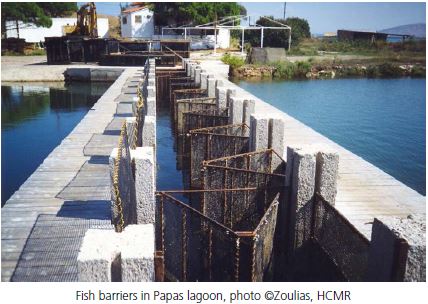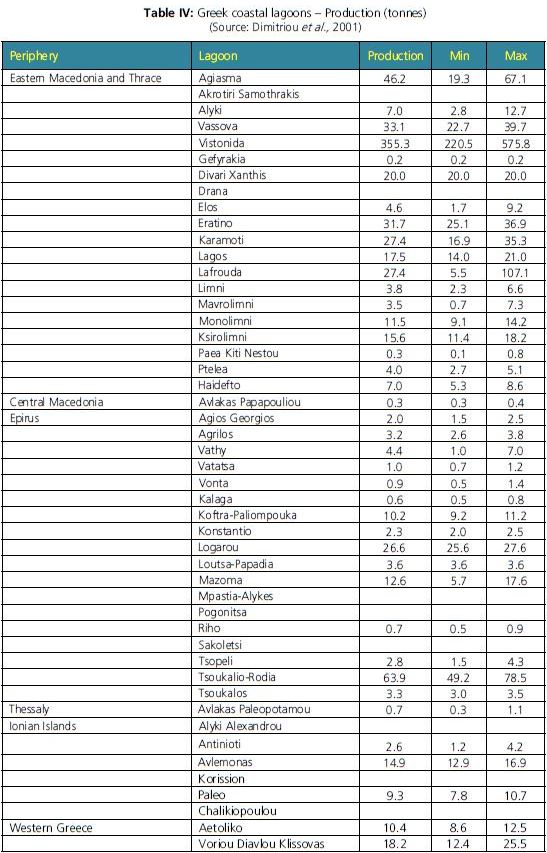5.5 Lagoon exploitation
The main activities carried out in the lagoons in Greece are fisheries, aquaculture, tourism/recreation, water management, nature conservation and research. Coastal lagoons also provide essential goods and services making with many conflicting interests, from fisheries to tourism and from aquaculture to urban development.
The fishery exploitation in the lagoons in the past was mostly based on traditional fish barriers consisting of wooden poles sustaining a net of reeds (Fig. 3), however, after the 1980s most of these installations were replaced with cement installations that copied the Italian vallicoltura capture systems (Fig. 4) (Koutrakis et al., 2007; Tsihrintzis et al., 2007).
Traditional fish barriers made out of reeds, photo ©ETANAM: Development
Agency for South Epirus – Amvrakikos SA

Fish barriers in Papas lagoon, photo ©Zoulias, HCMR
In some lagoons nets (mainly trammel nets) are also used. During spring fish enter the lagoons and the commercial species are caught by entrapment devices during their reproductive migration to the sea. Immature fish spend the cold season in dredged deep channels, the wintering channels (Koutrakis et al., 2007). A restocking with fry can also be carried out. Most lagoons are leased to local fisher cooperatives and several commercial species (various species of grey mullets such as Liza saliens, L. aurata, L. ramada, Chelon labrosus and Mugil cephalus, gilthead seabream Sparus aurata, European seabass Dicentrarchus labrax and eel Anguilla anguilla. are traditionally exploited, entering seasonally through the openings to the sea (Zoulias, 2003; Nicolaidou et al., 2005; Koutrakis et al., 2007).
Another traditional product of considerable commercial value is the fish roe made from the female ovaries of the flathead grey mullet (Mugil cephalus). The highest production of fish roe is attributed to Messolonghi lagoon and it is called “Avgotaracho Messolonghiou”. Other lagoon products are Caramote prawns Penaeus kerathurus, Mediterranean mussels Mytilus galloprovincialis and grooved carpet shell, Ruditapes decussatus.
5.5.1 Aquaculture and capture fisheries
Facilities
Fishing gear
The fishery exploitation is mostly based on fish barriers however also nets such as trammel nets and fyke nets are used.
Boats
Small motor boats are used in the lagoons.
Buildings and infrastructures
Fish landing sites are present, and in some lagoon there are offices and cold storage; packing rooms can be constructed.
Work force, establishments and institutions
The lagoons belong to the state and are managed by local regional authorities, where the major part is leased to local fisher cooperatives, and in few cases also to private companies. All the lagoons in north Greece and in the Amvrakikos Gulf are leased to fisher cooperatives supporting about 300 and 450 fishers respectively, whereas in Messolonghi part of the lagoons is leased to local cooperatives and part of them can be also exploited by individual fishers. Messolonghi lagoons support about 60 fishers belonging to fishing cooperatives and 600 individual fishers (Koutrakis et al., 2007).
Aquaculture and capture fisheries management
Restocking
In many lagoons, restocking with M. cephalus, D. labrax and S. aurata fry is carried out. Immature fish spend the cold season in the wintering channels, which are dredged deeper channels. In some lagoons (e.g. Papas lagoon in Peloponnese), semi-intensive fish aquaculture of S. aurata with food additions is carried out.
Selective fishery
The fishery exploitation in the lagoons is mainly based on fish barriers consisting of cement installations. Fish enter the lagoons during spring and the commercial sizes are caught by entrapment devices.
Overwintering strategies
Construction of wintering channels for the development of immature fish during the cold season.
Productions
Table III shows the fish production of the lagoons for each periphery in Greece. The highest abundance in catches is observed in September and October. Production rates during this time period may almost reach 90 percent of total production (Koutrakis et al., 2007). The most productive lagoons in Greece are located in Eastern Macedonia and Thrace, western Greece and Epirus (Table IV).
Table III: Lagoon production (tonnes) for each periphery in Greece (Source: Dimitriou et al., 2001)

Table IV: Greek coastal lagoons – Production (tonnes)
(Source: Dimitriou et al., 2001)

Mugilidae are the major part of the total production of the lagoons in Greece, whereas the mean composition of the fishery production is approximately formed by 56 percent Mugilidae, 22 percent eels, 8 percent seabass, 5 percent seabream, 4 percent gobiidae and percent other species (Dimitriou et al., 2001) (Fig. 3).

Figure 3. Mean composition (%) of lagoon production in Greece
5.5.2 Other uses
Recreational activities such as fishing and wildlife observation are carried out in some coastal lagoons.